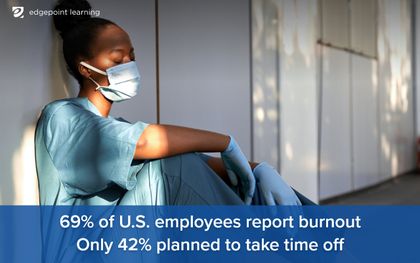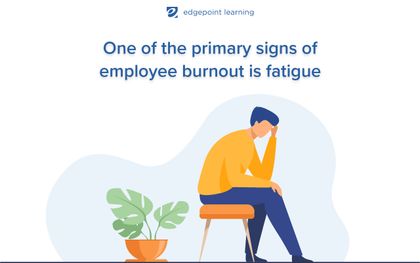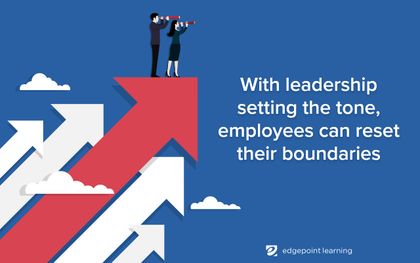8 Signs Of Burnout At Work In Employees (And How To Manage It)
Corey Bleich
🍿 7 min. read
Employee burnout is at an all-time high. Here's what you can do to support your employees.
Whether you are all gathered around the same conference table daily, working with your head down in individual cubicles, or transitioning to remote work, one thing is constant: employee burnout is possible, especially now. Here’s how to recognize the common signs of burnout at work (and what to do about it!).
Why is employee burnout so important to manage now?
As COVID-19 sent many employees home to work remotely, you might think that employee burnout eased. After all, who wouldn’t want to work in their jammies all day, on their own schedule? Many employers were concerned that the perception of casual day, every day, would lead to plummeting productivity. But the exact opposite has actually been true. Employees have been more productive amidst the stress of 2020, and employee burnout is now at an all-time high.
In 2020, a survey by Glint found a spike in employee burnout, adding to an upward trend that started back in the middle of 2019. Other studies confirm this trend, adding more troubling statistics.
- In July 2020, a survey of employees in the U.S. found 69% of them reporting burnout
- Despite their reporting, fewer than half (42%) planned to take any time off
- Another 59% of employees are taking less time off than in the past
Front-line workers are obviously at risk of employee burnout due to their increasingly intense days. However, another study found that the chance of developing employee burnout is the same whether you work in an office or at home: 43%.

Working remotely during a pandemic adds incalculable amounts of stress to an employee's responsibilities, and not only in terms of managing the logistics of that work from home transition. Many employees are also managing a household cooped up in quarantine or navigating their children's new online education.
The consequences of employee burnout are real.
Burnt out employees are 63% more likely to take sick leave, and 23% more likely to visit the emergency room. And the mental health consequences can be fatal. In Japan, the practice of suicide due to employee burnout is so prevalent that they have a word for it: karojisatsu.
Protecting your employees from the physical and mental stress of employee burnout can be harder if many are working remotely, but their lives may depend on it… literally.
Common signs of burnout at work
The temporary stress of a quickly approaching deadline is not the same thing as employee burnout. In the first case, that helpful jolt of adrenaline and cortisol from the stress helps you get the job done on time. In the second case of burnout, the reverse can actually occur.
Here are eight common signs of employee burnout to be aware of among your employees.
1. Fatigue
One of the primary signs of employee burnout is fatigue. This fatigue is unrelieved by a full night of sleep or naps during the day.
2. Insomnia
On the other hand, in the early phases of employee burnout, your employees may report more insomnia. While this is normal during short periods of stress, it can become chronic as burnout progresses.
3. Difficulty concentrating
This includes not only the inability to focus on something for prolonged periods of time, but also forgetfulness and a general sense of being scattered or disorganized.
4. Increase in sick days
Employees at risk for burnout will begin to take more sick days, leave early, or come to work late.
5. Mood disorders
Anxiety and depression are clear signs of employee burnout, especially in cases where employees did not have these disorders as a pre-existing condition.
6. Anger
Do you notice an employee getting easily irritated, frustrated, or angry? They may explode at the smallest provocation, or they might have a low simmer of anger that is visible in their interactions with co-workers.
7. Lack of engagement
Employees may begin to withdraw from groups and meetings. They may choose not to participate in social gatherings (or chime in on group emails). This mental and physical detachment is a protective mechanism for employees who are in the later stages of employee burnout.
8. Poor performance or reduced productivity
Has your formerly stellar employee been turning in sub-par work, turning it in late, or completing fewer tasks? Are simple things taking them longer? This is another very common sign of employee burnout.

How to manage employee burnout
Knowing how to manage employee burnout (especially when many of those employees are working remotely) is crucial.
Before implementing any new employee burnout prevention strategies among your managers, make sure those managers have mental health training. Not only does this help them be attentive to any issues that might arise, but it also helps managers and leaders be attentive to their own mental health as they begin to more actively support others.
Once your managers are on board, ask them to do the following for their teams.
Managing employee burnout starts with empathetic leadership
It’s easy to look at low productivity and poor performance and make assumptions, but there is a better way. Managers should seek first to understand what’s going on with your employee before rushing to judgment. If a stellar employee begins missing deadlines, a conversation is in order rather than a scolding or disciplinary action.
Recognize that employee burnout is not like a cold or the flu
Burnout doesn’t just clear up on its own, and treating the symptoms is not the solution. Don’t ignore the problem. Use the following approaches, and make sure employees feel supported along the way.
Make a concerted effort to manage burnout, while also acknowledging that it can be a long process (especially with the increased cognitive load due to COVID-19).
Evaluate their workload
Are managers making employees do more with less? That will only last for so long before they burnout.
As a company or department, ask what is non-negotiable in terms of deliverables, and what can be delayed? What extra assignments are worth putting on the back burner? Where can you streamline processes or bring in additional help? Especially consider the added demands of employees working remotely or those actively managing care or education for their children.
Mandate time off for all employees
If your employees are answering emails and delivering reports at 10 p.m. on Saturday night, they are headed for disaster.
Set company policies to discourage email use after a certain time every day, and work with employees to schedule regular time away from work. Set the expectation early and often that you don't expect employees to respond to emails during off hours, days off, or weekends.
Also give employees the resources they need to completely take time off. This may include restructuring certain processes or clearly communicating what resources they'll have to support their time off. Too often employees scramble to do all of their work before they leave, and then spend the days after a break scrambling to catch up. This simply isn't restorative, nor is it giving them the true break they need.
With leadership setting the tone, employees can slowly reset their boundaries and take the time off that they need.

Check in with employees before they burn out
In 2021, your employees are dealing with their normal duties, plus a pandemic, plus a fiery political transition, plus economic uncertainty in the face of state-by-state shutdowns.
Schedule regular check-ins with employees to get a sense of how they are handling their workload and personal concerns. Provide mental health support or other resources when they feel overwhelmed.
If you can, beef up your mental health services
Small businesses may struggle to offer adequate healthcare options for employees, but if you can, add this to your to-do list.
If full-scale mental health coverage isn't possible, find local or more affordable mental health options that you can offer as perks to employees. This may be reduced rates for local therapy groups, or free subscriptions to self-care or meditation apps. It may be a certain number of paid hours off each month for self-care or mental health time.
Encourage employees to support each other
It’s easy to have an “everyone for themselves” mentality, especially when working remotely, but that’s a slippery slope to detachment and employee burnout.
Work to cultivate a sense of community that helps employees feel they are supported, appreciated, and valuable. Don't do this through forced Zoom hangouts or more time on the clock. Instead, encourage a culture where people aren't expected to be "on" all day and night and weekends. Create a culture of appropriate and healthy boundaries, so your employees can become happier and more centered contributors to your teams.
Communicate your new approach
Whether we are wading through the mire of a global pandemic or simply moving through business as usual, it’s important to be alert to the signs of employee burnout. This was a trend that started long before 2020, and it’s up to compassionate managers and empathetic leaders to make some changes.
A good way to communicate your support of healthier boundaries is with on-the-job aids, shorter microlearning options for required training, and manager training about employee burnout. EdgePoint Learning has extensive experience in creating better mental health resources and training for global employees.
Contact us today to learn more about how we can help.
